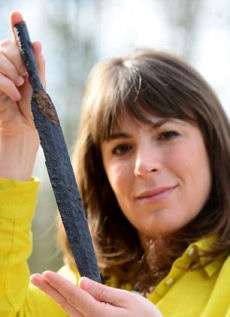|
Report to the Pocklington History Group AGM in April 2016.
 The archaeological excavations at Burnby Lane were completed late last year and the finds, artefact and skeletal, are now in the post-excavation analysis stage. The archaeological excavations at Burnby Lane were completed late last year and the finds, artefact and skeletal, are now in the post-excavation analysis stage.
It is expected that it could take several years before the full findings are published, but an initial report is expected in the next two to three months; and Paula Ware, from MAP Archaeology, has confirmed that she will give another detailed summary to the public which the history group is organising for February 2017.
Without wishing to steal any of Paula’s thunder I can give a brief update on what has been found and where we are with the efforts to keep and showcase the finds in Pocklington.
The dig has produced around a thousand artefacts and some 160 burials from 76 square barrows. The grave goods include a sword, a dozen spears, the remains of a shield, 600 glass beads and over 20 brooches.
The developers, David Wilson Homes, remain committed to the artefacts remaining locally and see the history group as the key organization in taking that forward. We are now in preliminary negotiations to try and display them in Pocklington, and the town council is likely to work in collaboration with the history group to explore a number of local options.
The burials include three men identified as warriors, several children - some of significant status with bangles and grave goods - and the women burials contain one who died in child birth. The range of burial types, including speared and crouched, itself warrants major study and explanation.
While the majority of the artefacts span the Iron Age era; significant additional interest has been generated a small number of burials indicative of the early Anglian period. Grave goods from these burials, specifically polychrome glass beads and a square-headed brooch, have been identified by Paula Ware, with further expert archaeological opinion from Hull University’s Peter Halkon and Manchester University’s Melanie Giles, as being typical of the 5th to 7th century.
Other East Riding excavations have also seen this pattern of a small number of early Anglo-Saxon burials within a major Iron Age site; and it is hoped that further investigation of the skeletons, including isotope analysis, can shed more light on the link between the two periods. It will also hopefully produce more information on Pocklington’s progression from what is now confirmed as a significant Parisi settlement into its next era as a Saxon town.
It is the post-excavation analysis of the skeletons which seems to excite the experts as much as the artefacts that have been discovered. In addition to the Iron Age to Saxon connections, it could also inform and answer questions about a number of long-standing Arras Culture issues, including whether the Parisi were a native tribe or had migrant origins.
The excavation may be complete, but there is much more information still to come, plus much work to do if we are going to make the showcasing of the finds into a reality.
Phil Gilbank
April 2016
|

